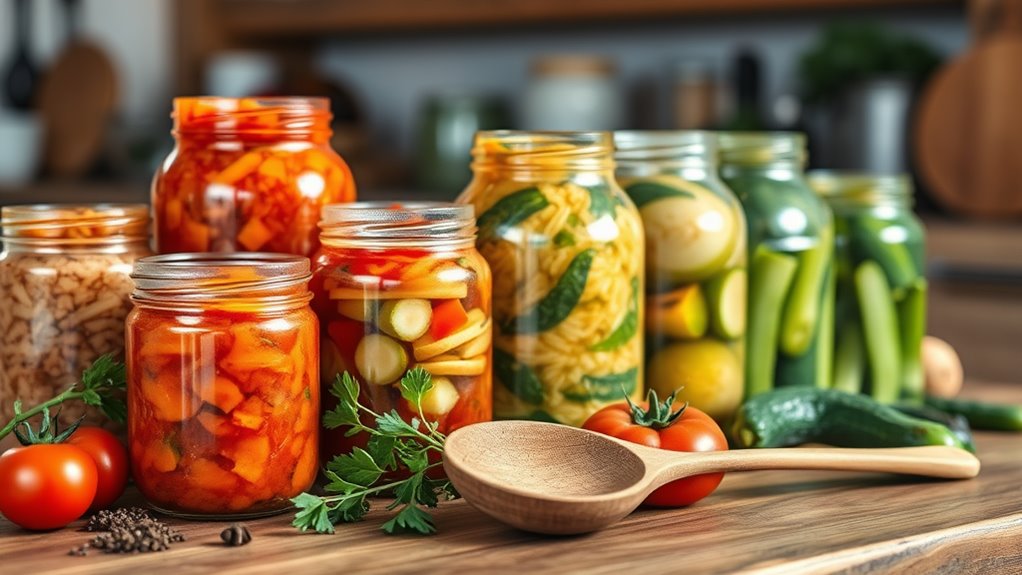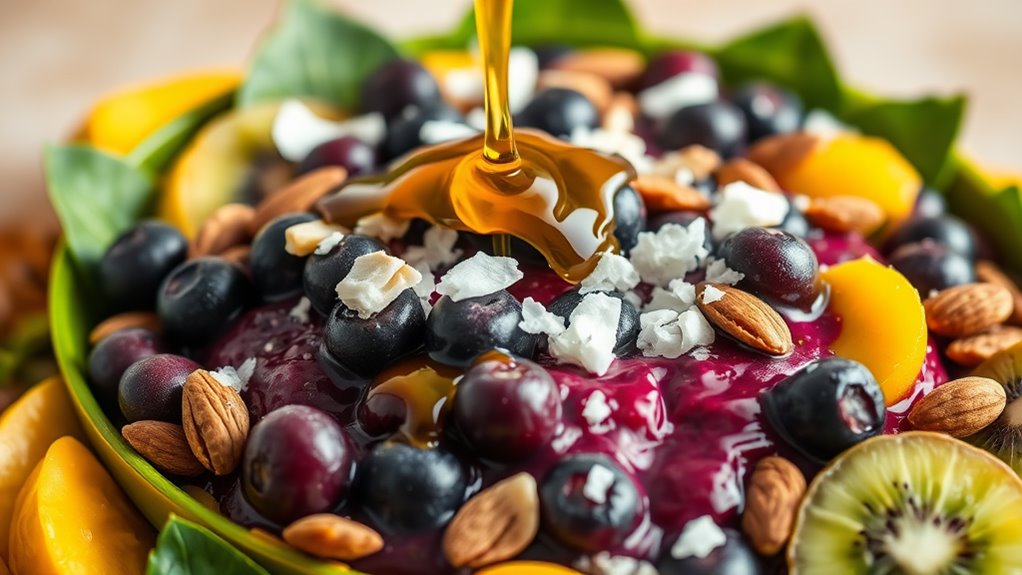Simple Fermented Recipes That Are Perfect for Beginners
If you’re new to fermentation, start with simple recipes like sauerkraut, homemade yogurt, and kimchi. Shredding cabbage and mixing it with salt is an easy way to make sauerkraut. For yogurt, just heat milk, mix in a yogurt starter, and keep it warm. Want something fruity? Try making easy fruit vinegar by fermenting fruit with sugar and water. You can even create a refreshing water kefir. Keep exploring these flavors for more delicious options!
Key Takeaways
-
Sauerkraut is a great starter; just shred cabbage, mix with salt, and ferment for 1-4 weeks to enjoy its crunchy, tangy flavor.
-
Simple Kimchi involves napa cabbage, spices, and a few days of fermentation for a flavorful addition to meals.
-
Fermented vegetables like cucumbers or carrots provide vibrant flavors and beneficial probiotics, making them easy and rewarding to create.
-
Homemade yogurt requires just milk and a store-bought yogurt starter; heat, mix, and incubate for a creamy, probiotic-rich yogurt.
-
Water kefir is perfect for beginners; mix water, sugar, and kefir grains, ferment for a couple of days, and enjoy the refreshing beverage.
Sauerkraut: A Crunchy, Tangy Delight
Sauerkraut, with its vibrant crunch and tangy flavor, is a fantastic introduction to the world of fermentation.
As you embark on this journey of fermentation for beginners, you’ll find that making sauerkraut is simple and rewarding. Start by shredding fresh cabbage and mixing it with salt. This creates the brine needed for fermentation.
Pack the mixture into a jar, pressing down to eliminate air pockets, and let it ferment at room temperature for about one to four weeks. During this time, you’re cultivating beneficial bacteria that give sauerkraut its signature tang.
Interestingly, sauerkraut is not just delicious but also packed with health benefits that support your overall well-being.
Each taste reflects your effort and connection to the age-old tradition of preserving food. So roll up your sleeves and dive into making your own batch of this delightful, crunchy condiment.
Homemade Yogurt: Creamy and Probiotic-Rich
Building on your fermentation skills, making homemade yogurt is another simple yet rewarding process. You’ll love how creamy and probiotic-rich it turns out! All you need is milk, a scoop of store-bought yogurt as a starter, and a little patience.
Here’s a quick glance at your yogurt-making essentials:
| Ingredient | Purpose |
|---|---|
| Milk | Base for yogurt |
| Starter yogurt | Introduces cultures |
| (Optional) Sweeteners | Adds flavor |
Heating the milk encourages the growth of beneficial bacteria, which helps transform it into yogurt. Let it cool, mix in the starter, and keep it warm for several hours. Soon, you’ll have a delightful homemade yogurt ready for toppings or just enjoying on its own. Enjoy this simple pleasure!
Simple Kimchi: A Spicy Fermented Favorite
Making simple kimchi is easier than you might think! You’ll want to gather key ingredients like napa cabbage and Korean red pepper flakes before following the fermentation steps. Fermentation process is crucial for developing the unique flavors and health benefits associated with kimchi. Let’s get started on this spicy fermented favorite that can elevate any meal!
Key Ingredients to Use
To create simple kimchi, you’ll need just a handful of key ingredients that deliver a burst of flavor and spice.
Start with fresh napa cabbage, the heart of your kimchi, and chop it into delightful bite-sized pieces. You’ll want to sprinkle salt over the cabbage, allowing it to soften and release its natural juices.
Next, reach for Korean red pepper flakes, or gochugaru; it brings that signature heat and depth of flavor. Don’t forget garlic and fresh ginger for that aromatic touch.
For a hint of sweetness, a small amount of sugar can balance the spice. Finally, include a splash of fish sauce or soy sauce for a savory kick.
With these essentials, you’ve truly set the stage for a deliciously vibrant kimchi!
Fermentation Process Steps
Once you’ve prepped your ingredients, it’s time to dive into the fermentation process of your simple kimchi. Start by mixing your veggies with spices, ensuring even distribution. Next, pack this vibrant mixture tightly into a clean jar, allowing some space at the top for expansion. Seal the jar and let it sit at room temperature for a few days, letting the magic of fermentation unfold.
Here’s a quick reference for the process:
| Step | Action |
|---|---|
| 1 | Combine and mix ingredients |
| 2 | Pack into jar tightly |
| 3 | Seal the jar |
| 4 | Let it ferment at room temp |
Taste it after a few days—your simple kimchi will be bursting with flavor!
Fermented Vegetables: A Rainbow of Flavors
Fermented vegetables bring a vibrant array of colors and flavors to your kitchen, inviting you to explore a world of taste.
You’ll love how easy it’s to create these delightful, tangy bites that add excitement to your meals. Here are some fruits you might want to start with:
- Crunchy cucumbers for classic dill pickles
- Bright carrots, perfect for adding a sweet crunch
- Colorful beets, packed with earthy goodness
- Spicy radishes to give a kick
- Flavorful cabbage for homemade sauerkraut
Experimenting with combinations not only enhances your palate but also brings an added health boost. Additionally, incorporating beneficial probiotics into your diet through these recipes can significantly improve your gut health.
Easy Fruit Vinegar: Sweet and Tangy Elixir
Making your own fruit vinegar is a fun and rewarding process.
You’ll need just a few ingredients to get started, and I’ll walk you through the fermentation process step-by-step.
Plus, I’ll share some flavor variations that’ll keep your creations exciting and unique!
Ingredients for Fruit Vinegar
To create a delicious fruit vinegar, you’ll need just a few essential ingredients that come together to form a sweet and tangy elixir.
Gather these simple yet delightful components to kickstart your fermentation journey:
- Fresh, ripe fruit (like apples, berries, or peaches)
- Granulated sugar or honey (to sweeten and feed your fermentation)
- Filtered water (to keep things pure and clean)
- Vinegar starter (like raw apple cider vinegar; it contains the necessary cultures)
- A clean, glass jar (to house your creation as it transforms)
With these ingredients in hand, you’re ready to craft something truly special that’ll elevate your meals and drinks.
Enjoy the process, and savor the transformation!
Fermentation Process Explained
Once you’ve gathered your ingredients, it’s time to kick off the fermentation process for your sweet and tangy fruit vinegar.
Start by mixing your fruit, sugar, and water in a clean jar, leaving a bit of space at the top. Cover it loosely with a cloth or lid; you want air to flow in while keeping dust and insects out.
Set it aside in a cool, dark spot for about a week. During this time, you’ll notice bubbles forming as the wild yeast begins to work its magic. Give it a gentle stir daily, coaxing those flavors to develop.
After seven days, strain out the solids and allow the liquid to ferment for another 2-4 weeks. Enjoy the journey!
Flavor Variations to Try
While experimenting with different fruits, you’ll discover a whole new world of flavors for your easy fruit vinegar. Each fruit adds its unique twist, inviting you to dive deeper into your culinary adventure.
Here are some delicious variations to try:
-
Strawberry and Basil: A refreshing combo that brightens up salads.
-
Peach and Ginger: Sweet and spicy, perfect for marinades.
-
Raspberry and Mint: A vibrant mix that awakens your senses.
-
Apple and Cinnamon: Cozy and warming, ideal for fall recipes.
-
Pineapple and Jalapeño: A tropical kick that’s simply irresistible.
Let your imagination run wild! Mixing and matching fruits will make each jar an exciting surprise, perfect for dressing up dishes or sipping on its own.
Water Kefir: A Refreshing Probiotic Drink
If you’re looking for a delicious way to boost your gut health, water kefir is an excellent choice. This refreshing, fizzy drink is packed with probiotics that can help support your digestive system.
Making water kefir is simple and enjoyable—just combine water, sugar, and kefir grains. Over a couple of days, the grains will ferment the mixture, transforming it into a tangy beverage that’s both hydrating and nourishing.
You can personalize your drink by adding fruits, herbs, or spices during the second fermentation. Sip on it chilled in the summer or mix it into smoothies for an extra kick.
With water kefir, you’re not just quenching your thirst; you’re nurturing your body in the most delicious way.





